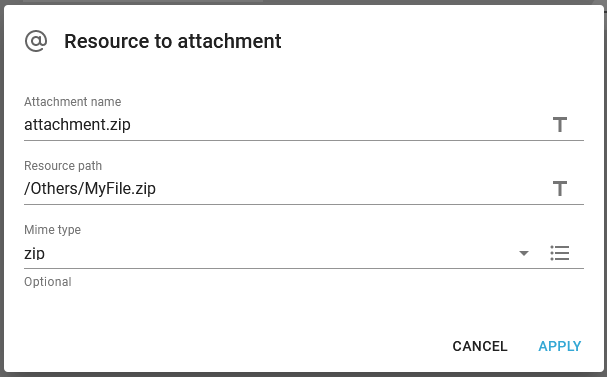You can attach any file from the NG2 resources as an attachment to an email with the workflow component, Resource to attachment. The email can later e.g. be emailed or saved with this resource with either of the components, Create PDF email or Create EML with PDF. All email options are covered here.
Similar workflow components are:
Payload to attachment and URL to attachment. The component, Rename attachment is also related.
You can combine this workflow component with the Save in resources component.
The Resource to attachment components has these parameters:

Attachment name
The name to use for the attachment. This can be either a constant or an XPath expression. If you see an attachment name when you receive the email like this:

Then you are probably using an invalid characters in the attachment name. There is no standard as to which characters, that are allowed so you need to test for invalid characters and e.g. replace characters not found in the lists: a-z, A-Z and 0-9. On one mail server the dash (minus) character caused such an attachment name.
Resource path
This is the path and name of the resource, that you want to attach. The first part of the the path is the resource folder/type of the library, which in the example above is Others.
The folder for the resources are:
Resource |
Path |
Example |
|---|---|---|
Components |
/templateComponent |
/templateComponent/Common/Footer.icmp |
Documents |
/documents |
/documents/Demo/Demo_Invoice.xml |
Fonts |
/font |
/font/arial.ttf |
Images |
/image |
/image/Demo/Leif1.jpg |
Mail templates |
/mailTemplate |
/mailTemplate/defaultMailTemplate.vm |
Other |
/other |
/other/Certificates/MOCES_gyldig.p12 |
Styles |
/style |
/style/header.style |
Templates |
/template |
/template/Demo/InvoiceDemo.ift |
Transforms |
/transform |
/transform/production/copyNode.xsl |
Translations |
/translation |
/translation/Demo/translate.properties |
Validation rules |
/validationRule |
/validationRule/Training/Validate_demo_xml.xsd |
Workflow |
/workflow |
/workflow/KSE_test.wf |
Mime type
Here you can set a specific mime type for the attachment, so that the receiver can identify the file type. This is optional. Most often the extension of the attachment name should be enough to identify the mime type. Examples of mime types are listed here: https://developer.mozilla.org/en-US/docs/Web/HTTP/Basics_of_HTTP/MIME_types